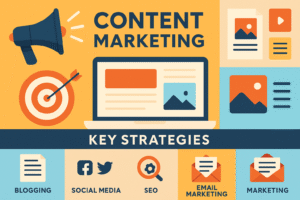What is Google Ads?
Google Ads is an online advertising platform that places your message across Google Search, YouTube, and millions of partner sites. It runs on a pay-per-click (PPC) model—you pay when someone clicks your ad. When a user searches, advertisers bid on relevant keywords. Google evaluates your bid, ad quality, and relevance to decide which ads appear. The result is highly targeted traffic that can arrive almost instantly.
Why Use Google Ads?
- Instant visibility: Get to the top of search results fast.
- Targeted reach: Narrow audiences by keywords, location, device, and demographics.
- Flexible budgets: Set daily caps and adjust anytime.
- Measurable results: Track clicks, conversions, and impressions in real time.
- Diverse formats: Text, display, video, shopping, and app campaigns for any goal.
Types of Google Ads Campaigns
Choosing the right campaign type aligns your spend with your goals—brand awareness, lead generation, or direct sales.
- Search Ads – Text ads shown on search results pages.
- Display Ads – Visual banners across Google’s Display Network.
- Video Ads – Skippable or non-skippable ads on YouTube.
- Shopping Ads – Product listings with images, prices, and ratings.
- App Campaigns – Drive app installs and in-app actions.
Google Ads Guides: Best Practices for Beginners
1) Start with Keyword Research
Use tools like Google Keyword Planner to find relevant, high-intent keywords. Prioritize terms that reflect purchase intent and match your offer.
2) Write Compelling Ad Copy
Grab attention with clear headlines, a unique value proposition, and a direct call-to-action. A/B test multiple variations to improve click-through rate (CTR).
3) Use Negative Keywords
Exclude irrelevant searches to cut wasted spend and sharpen targeting. Regularly expand your negative list from search term reports.
4) Optimize Landing Pages
Match the landing page to the ad promise. Ensure fast load speed, mobile-friendliness, and a focused conversion path with a single, prominent CTA.
5) Track Conversions
Implement conversion tracking via Google Ads or Google Analytics. Attribute performance to keywords, ads, and audiences to guide budget allocation.

Advanced Optimization Tips
- Bid to performance: Increase bids for high-converting queries; reduce on underperformers.
- Leverage ad extensions: Sitelinks, calls, and locations increase real estate and engagement.
- Ad scheduling: Run ads when your audience is most active.
- Remarketing: Re-engage visitors who didn’t convert the first time.
Common Mistakes to Avoid
- Overly broad keywords that invite irrelevant clicks.
- Ignoring Quality Score, which impacts cost and visibility.
- Sending traffic to a generic homepage instead of a tailored landing page.
- “Set and forget” campaigns—optimization should be continuous.
Conclusion
This article in the Google Ads Guides series gives you a practical roadmap—from PPC basics and campaign formats to optimization tactics. With continuous testing, smart bidding, and strong landing pages, your campaigns can deliver measurable results and sustained ROI.



